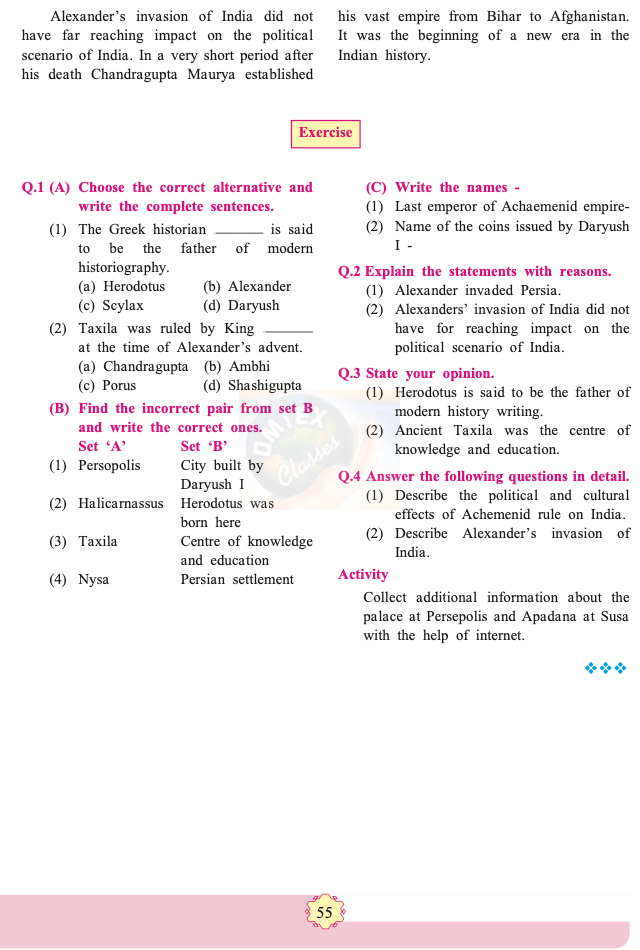Chapter 7: India and Iran (Persia)
Choose the correct alternative and write the complete sentence.
The Greek historian ______ is said to be the father of modern historiography.
OPTIONS
Herodotus
Alexander
Scylax
Daryush
SOLUTION
The Greek historian Herodotus is said to be the father of modern historiography.
Taxila was ruled by King ______ at the time of Alexander’s advent.
OPTIONS
Chandragupta
Ambhi
Porus
Shashi Gupta
SOLUTION
Taxila was ruled by King Ambhi at the time of Alexander’s advent.
Find the incorrect pair from set B and write the correct ones.
SOLUTION
Write the names.
Last emperor of Achaemenid empire-
SOLUTION
Last emperor of Achaemenid empire - Daryush - III
Name of the coins issued by Daryush I -
SOLUTION
Name of the coins issued by Daryush I - Darik and Siglos
Explain the statement with reasons.
Alexander invaded Persia.
SOLUTION
The Persians invaded Greece but were defeated. Thereafter the conflict between the Achaemenids and Greeks continued over a prolonged time.
An impact of this conflict was to manifest in the way of the invasion of Persia by Alexander III, the King of Macedonia.
Thus, Alexander invaded Persia.
Alexanders’ invasion of India did not have far reaching impact on the political scenario of India.
SOLUTION
Alexander invaded India and conquered some kingdoms from Afghanistan to Sindh-Punjab. He could not however establish his rule for a long time.
After his confrontation with Porus, Alexander proceeded in the direction of Chenab and Ravi.
He conquered the kingdoms on the way and reached the bank of Beas. Alexander's soldiers had lost spirit and they refused to march forward.
Before setting on the return journey. Alexander handed over the regions in Punjab to Porus and those in Sindh to Ambhi.
He appointed Greek satraps and in 325 B.C.E.
Alexander died in Babylon. After his death, Chandragupta Maurya established his vast empire from Bihar to Afghanistan.
State your opinion.
Herodotus is said to be the father of modern history writing.
SOLUTION
Herodotus was the first historian who collected information seeking answers to a particular question and then to put it in chronological order. While doing this he did not bring in notions like a god, human destiny, etc.
Putting historical events in a chronological sequence became an essential theme of history writing.
This theme proved to be fundamental in the development of history writing as an independent discipline.
Therefore, Herodotus is said to be the father of historiography.
Ancient Taxila was the centre of knowledge and education.
SOLUTION
Buddhist literature and writings of the Greek historians give information about Taxila.
There were several learned individuals (Acharyas) staying in Taxila.
Many students from various regions of the Indian subcontinent were attracted to Taxila because of the fame of the acharyas.
Thus, Taxila had become a great centre of education.
Thereby it had assumed the magnitude of a natural university.
Answer the following question in detail.
Describe the political and cultural effects of Achemenid rule on India.
SOLUTION
The Persian supremacy prevailed in the Indian subcontinent for at least two centuries.
The Persian rulers set up an administrative system.
Every conquered region was annexed to their territory as a satrapy and a satrap (governor) was appointed as its chief administrator.
A newly opened waterway for the transport between Persia and the Indian subcontinent facilitated trade between Achaemenid provinces in the northwestern region of the Indian subcontinent and the regions of Sindh-Punjab.
The ivory and teak exported from India had great demand in the Persian markets. The architects, sculptors, and other artisans lost the royal patronage so they had to move out in search of work. They migrated to India.
They received royal patronage in the court of emperor Ashoka. Their style is reflected in the stone pillars erected by Emperor Ashoka.
Thus, the sculptural art in ancient India has its roots in the Persian; and accordingly, in the Greek sculptural style.
Balbharati Solutions for History 11th Standard Maharashtra State Board
• Chapter 2: First Cities of India
• Chapter 3: Chalcolithic Villages in India
• Chapter 5: Janapadas and Republics
• Chapter 6: Second Urbanisation in India
• Chapter 7: India and Iran (Persia)
• Chapter 8: India during Mauryan period
• Chapter 9: Post Mauryan India
• Chapter 11: Kingdoms in South India
• Chapter 12: India, Nations in the northwest of the Indian Subcontinent and China
• Chapter 13: India, Shri Lanka and Southeast Asia
• Chapter 14: Delhi Sultanate, Vijayanagar and Bahamani Kingdom
• Chapter 15: India during Mughal period
• Chapter 16: Swarajya to Empire (Maratha period)
.







